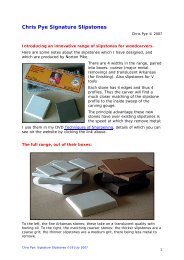Joiner and - Tools for Working Wood
Joiner and - Tools for Working Wood
Joiner and - Tools for Working Wood
Create successful ePaper yourself
Turn your PDF publications into a flip-book with our unique Google optimized e-Paper software.
takes one of the shorter pieces <strong>and</strong> fixes it in the vice end uppermost,<br />
<strong>and</strong> with that face towards him which he intends to be the inside of<br />
the box. He then marks out upon the end with his pencil, the pins of<br />
the dovetail, as they are called. Six of them are about the right number<br />
in a box of this depth; one is hidden in the drawing by the projecting<br />
piece of wood which runs round the bottom of the box. One is made at<br />
each extremity of the wood, <strong>and</strong> the others at regular distances between<br />
<br />
a part of the joint is shewn on a larger scale, <strong>and</strong> with the two pieces of<br />
it not yet put together. From this figure, the reader will see the reason<br />
of the name given to the joint; these pins are something the shape of<br />
a dove’s tail. It was on dovetails like this, with not more than three or<br />
four pins, that Thomas practised at first. It will be seen that the pins are<br />
made thicker towards the inside of the box than towards the outside. In<br />
a joint of this size they may be made a quarter of an inch in the thickest<br />
part, <strong>and</strong> an eighth in the thinnest; the two outside ones may be a little<br />
stouter. And care should be taken to make them regular, <strong>and</strong> with both<br />
sides sloping equally. Having marked them out on the end, Thomas next<br />
marks them square along the out side <strong>and</strong> inside as far as the gauge mark<br />
which he had be<strong>for</strong>e drawn across the piece of wood; <strong>and</strong> then he saws<br />
along the marks which he has made, taking care not to cut into the pins<br />
at all. The saw with which he does this is called a , <strong>and</strong> is a<br />
smaller <strong>and</strong> finer-toothed sash-saw. Thomas now takes the piece of wood<br />
out of the vice, <strong>and</strong> lays it flat on the bench, that he may cut away the<br />
parts between the pins, so as to leave the pins st<strong>and</strong>ing out, as shewn<br />
in fig. 3. This is done with a broad chisel, as broad as can go between<br />
the pins without touching them; <strong>and</strong> the chisel is struck with a wooden<br />
hammer, called a mallet. Thomas begins to cut from the outside, placing<br />
the edge of his chisel not exactly on the gauge mark, but a little nearer<br />
<br />
<br />
<br />
<br />
<br />
fi<br />
<br />
fi<br />
fi<br />
fi<br />
<br />
fi













